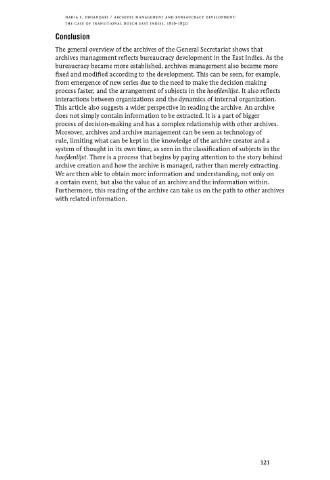Conclusion
The general overview of the archives of the General Secretariat shows that
archives management reflects bureaucracy development in the East Indies. As the
bureaucracy became more established, archives management also became more
fixed and modified according to the development. This can be seen, for example,
from emergence of new series due to the need to make the decision making
process faster, and the arrangement of subjects in the hoofdenlijst. It also reflects
interactions between organizations and the dynamics of internal organization.
This article also suggests a wider perspective in reading the archive. An archive
does not simply contain information to be extracted. It is a part of bigger
process of decision-making and has a complex relationship with other archives.
Moreover, archives and archive management can be seen as technology of
rule, limiting what can be kept in the knowledge of the archive creator and a
system of thought in its own time, as seen in the classification of subjects in the
hoofdenlijst. There is a process that begins by paying attention to the story behind
archive creation and how the archive is managed, rather than merely extracting.
We are then able to obtain more information and understanding, not only on
a certain event, but also the value of an archive and the information within.
Furthermore, this reading of the archive can take us on the path to other archives
with related information.
NADIA F. DWIANDARI ARCHIVES MANAGEMENT AND BUREAUCRACY DEVELOPMENT:
THE CASE OF TRANSITIONAL DUTCH EAST INDIES, 1816-1830
121

